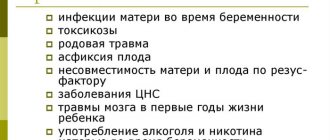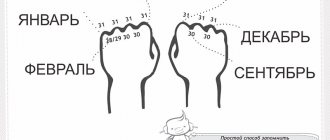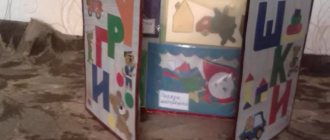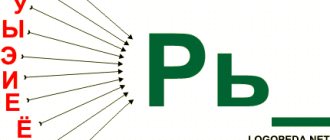Didactic game “Finish the sentence”
The lesson is intended for preschoolers in the preparatory group.
The goal of the didactic game “Finish the Sentence” is to develop the skill of using complex sentences in speech.
The teacher asks the students to complete the phrase:
- dad put the purchased bread... (in the bread bin);
- Mom poured salt... (into the salt shaker);
- grandfather put candy... (in the candy bowl);
- grandma baked pies, put them... (in a plate);
- my sister is lying in bed with a fever because... (had a cold);
- the radiators turned on in the apartment because... (it became cold);
- little brother doesn’t want to go to bed because... (it’s too early to sleep);
- our family will go for a walk in the park tomorrow if... (the weather is good);
- the cat climbed a tree so that... (the dog would not attack him);
- the neighbor went to the store to... (buy food).
Games for speech development in the senior group of kindergarten
Didactic games for the speech development of children in the senior group
“Find the extra word” Purpose:
to exercise the development of mental processes of generalization, abstraction, and identification of essential features.
Progress of the game.
Invite your child to identify the word that is redundant.
Read a series of words to your child. Each series consists of 4 words. 3 words in each series are homogeneous and can be combined based on a common feature, and 1 word differs from them and should be excluded. List of series of words: 1. Old, decrepit, small, dilapidated. 2. Brave, angry, daring, daring. 3. Apple, plum, cucumber, pear. 4. Milk, cottage cheese, sour cream, bread. 5. Hour, minute, summer, second. 6. Spoon, plate, pan, bag. 7. Dress, sweater, hat, shirt. 8. Soap, broom, toothpaste, shampoo. 9. Birch, oak, pine, strawberry. 10. Book, TV, radio, tape recorder “Is this true?” Goal:
development of auditory attention, activation of the verb vocabulary.
Progress of the game.
Children are read a poem containing absurd situations.
Children must answer the question: “Is this true? – after each sentence and prove why they think so. For the correct answer they get a chip. The one who gets the most chips wins. Is this true? They collect cheese from the bushes. Cows are grazed with hares. Oxen are being milked in the meadow. The bear starts dancing. The pumpkins began to sing songs. Mowers are mowing the forests. There is dew on the snow. Is it true that once an umbrella saved us from the rain? Why does the moon shine on us at night? What don't children like sweets? L. Stanch “The Fourth Extra” Purpose:
to teach to establish the similarities and differences of objects according to essential features, to consolidate generalization words.
Progress of the game.
Four pictures are laid out on the table, three of them belong to one thematic group, and the fourth to some other group.
The children are given a task: look at the pictures and determine which one is the odd one out. Turn over the wrong picture, and name the remaining ones in one word.” Each participant eliminates the extra picture in turn. If he makes a mistake or does not complete the task, his version is offered to the next player to complete. For each correct execution they give a chip. The one who collects the most chips wins. A series of pictures for the game: 1. Shirt, shoes, trousers, jacket. 2. Apple, gooseberry, currant, raspberry. 3. TV, wardrobe, chair, bed. 4. Cuckoo, owl, butterfly, magpie. 5. Plate, bread, pan, spoon. 6. Chamomile, birch, spruce, poplar. 7. Tomato, cucumber, carrot, plum. 8. Cap, beret, hat, sock. 9. Axe, saw, handle, plane. 10. Bear, fox, teddy bear, hare. “Right or wrong?” Goal: learn to find grammatical errors. Progress of the game.
“Do you think it’s possible to say that?”
1. Mom puts a vase of flowers on the table. 2. When they want to buy something, they lose money. 3. Grandmother and grandfather live under the house on the edge of the forest. 4. There is a beautiful carpet on the floor. “Why are the sentences inaccurate? – the teacher additionally asks the children. “Unravel the words” Goal: learn to compose sentences using these words. Progress of the game. The words in the sentence are mixed up. Try to put them in their place. What will happen? Suggestions for the game: 1. Smoke, coming, pipes, from. 2. Loves, little bear, honey. 3. Standing, in a vase, flowers, in. 4. Nuts, in, squirrel, hollow, hiding. “Find the error” Purpose: to teach how to find a semantic error in a sentence. Progress of the game. “Listen to the sentences and tell me if everything in them is correct. How should the sentence be corrected? 1. In winter, apples bloomed in the garden. 2. Below them lay an icy desert. 3. In response, I nod my hand to him. 4. The plane is here to help people. 5. I soon succeeded by car. 6. The boy broke the ball with glass. 7. After the mushrooms there will be rains. 8. In spring, the meadows flooded the river. 9. The snow was covered with a lush forest “Explain why...” Purpose: to teach correctly, construct sentences with a cause-and-effect relationship, develop logical thinking. Progress of the game. The facilitator explains that the children will have to complete the sentences that the facilitator begins to say using the word “because.” You can select several options for one beginning of a sentence, the main thing is that they all correctly reflect the reason for the event stated in the first part. For each correctly executed continuation, players receive a chip. The one who collects the most chips wins. Unfinished sentences for the game: Vova got sick... (got a cold) Mom took an umbrella... (it's raining) The children went to bed... (late) I'm really thirsty... (hot) The ice on the river melted... (warm) The trees swayed a lot... (the wind is blowing) It became very cold... (it started snowing) “Say a word” Goal: to reinforce the use of nouns in the genitive plural in speech. Progress of the game. Familiar lines of poetry are read aloud to children, without finishing the last word. (This word is in the genitive plural). Children add the missing word and receive a chip for each correct answer. The one who gets the most chips wins. *** I give you my word of honor: Yesterday at half past six. I saw two pigs. Without hats and... (shoes) *** Wait, wasn't it for you Last week. I sent two pairs of Excellent... (galoshes) *** Robin Bobin Barabek. Ate forty... (man) *** He said: “You are a villain, You devour people, So, for this my sword - Your head from... (shoulders) *** Ant, ant Does not regret... (bast shoes) *** Where is the killer , where is the villain? I’m not afraid of him... (claws) -5- “It flies, not a bird” Purpose: differentiation of the concepts of “birds” and “insects”. Progress of the game. The presenter asks riddles about birds and insects. Children solve the riddles and explain which thematic group this animal belongs to. If the answer is correct, the presenter gives the child a chip or a symbol of that animal. The one who collects the most chips wins. Before the game, the presenter reminds the children of the identifying characteristics of birds: they have feathers, beaks, claws, wings, they build nests and hatch chicks, they can sing, they are big. Insects are small, have six legs, do not hatch chicks, and have no feathers. In the dark dungeon, the maidens are beautiful. Without thread, without knitting needles Knitting. (Bees in the hive) *** Red paws Pinching the heels (Goose) *** Black, agile, Shouts “krak”, Enemy of worms. (Rook) *** Not an animal, not a bird, But a nose like a knitting needle. (Mosquito) *** Appeared in a yellow fur coat. Goodbye, two shells. (Chicken) *** A bird flew, Not feathered, not winged, Long nose, Thin voice. Whoever kills her will shed human blood. (Mosquito) Many craftsmen cut down a hut without corners. (Ants) *** A little boy in a gray shirt scurries around the yards, collects crumbs, spends the night in the field, steals hemp. (Sparrow) *** In a clearing near the fir trees, The house is built of needles. It is not visible behind the grass, but there are a million residents in it. (Anthill.) *** There is a palace on a pole, There is a singer in the palace, And his name is... (starling). *** I buzz, I buzz, I sit on a branch, I keep repeating the letter Z, Knowing this letter firmly, I buzz in the spring and summer. (Beetle) *** Vereshchanya, white-sided. And her name is... (magpie). *** The flower was sleeping and suddenly woke up: He didn’t want to sleep anymore. He moved, perked up, soared up and flew away. (Butterfly)
We recommend watching:
Games for the development of speech for children 5-7 years old Speech games and exercises for the development of speech for children 5-7 years old Didactic games for children 5-7 years old: Winter sports Didactic game for children 4-7 years old. Shop "Tails"
Similar articles:
Assignments on the topic “Forest” for children 6-8 years old
Methods of using didactic games in kindergarten in the senior preparatory group
Name the adjective
The goal of the game for the middle group of kindergarten is to teach the skill of completing a phrase with an adjective with an antonymous meaning.
The teacher says the beginning of the phrase, the children say the end, while pronouncing the opposite word:
- hot summer - winter... (cold);
- the road is wide - the path... (narrow);
- high cabinet - chair... (low);
- bright day - night... (dark);
- sweet honey - pepper... (bitter);
- the stem of a flower is thin - the trunk of a tree... (thick);
- loud scream - whisper... (quiet).
Find a word
The goal of the game for the older group of kindergarteners is to teach the skill of composing sentences with the selection of different nouns that are suitable in meaning.
For the lesson you need to prepare two groups of illustrations. In the first - mushrooms, apple, strawberry, textbook, crucian carp, in the second - cones, plums, daisies, pencils, pike.
At the first stage, lay out the first set of cards on the table. Say the phrase, ask the child to complete it, choose the correct picture from the list:
- grandfather collects in the forest... (mushrooms);
- the boy picked a ripe... (apple) from the tree;
- a girl in a clearing collects... (strawberries) in a basket;
- the student put it in his briefcase... (textbook);
- Dad caught ... (crucian carp) from the river with a fishing rod.
At the second stage, lay out the second set of pictures on the table, ask them to insert other words from those presented into the same sentences.
At the end of the game, ask what else can be collected in the forest (acorns, hazel, brushwood, leaves), what can be taken from fruit trees (pears, peaches, cherries, apricots), what fish can still be caught in the river (bream, roach, perch ) what schoolchildren put in their briefcase (notebooks, diary, pens, markers, paints).
“Unfinished Sentences” technique for children and teenagers
The technique belongs to the group of projective tests and consists of 56 unfinished sentences. Each of them is aimed at identifying the subject’s relationship to a particular group of social or personal interests and preferences.
Target
— study of the orientation of the student’s personality, the system of his relationships.
Research procedure: subjects are offered a form with 56 unfinished sentences, conditionally divided into 7 thematic blocks (8 sentences in each block): attitude towards learning, attitude towards school, attitude towards family, attitude towards peers, attitude towards oneself, attitude towards others people and their attitude towards their future.
Some groups of sentences relate to the fears and apprehensions a person experiences, to his feelings of guilt, and affect relationships with peers, parents, and his own life goals.
You should strive to complete the task quickly and not allow you to think about the answer for a long time.
Instructions.
“There are 56 unfinished sentences on the form. Read and complete them, writing down the first thought that comes to your mind. Do it quickly, don't hesitate. If you can’t finish a sentence, circle its number and work on it later.” The survey is carried out in two stages. At the first stage, subjects complete unfinished sentences; at the second stage, they assess their emotional attitude to the content of this ending.
Instructions for stage 2.
After reading each sentence, give it an emotional rating score: +1, 0, –1, on the following scale:
+1 - positive assessment and positive attitude towards what is being discussed, while experiencing positive emotions: joy, satisfaction, appreciation, gratitude, self-confidence, peace, etc.;
0 - neutral assessment and neutral attitude towards what is being discussed. Absence of any emotions. The proposal is not completed.
–1 – negative assessment, negative attitude towards what is being discussed. Experiencing negative emotions: irritation, anger, frustration, fear, sadness, resentment, envy, contempt, etc., or if the sentence is not completed due to strong unpleasant experiences associated with what is being discussed.
Examples: “School management... doesn’t bother me” (0); “At school I feel... at home” (+1); “Teachers are often inattentive to me” (–1).
Unfinished Sentence Sheet
1. This is how I study... 2. The school authorities... 3. My mother... 4. When I'm not there, my friends... 5. When I start to have bad luck... 6. Most of the people I know... 7. I think that in the future... 8 .I would like to study... 9. Our school... 10. Compared to most families, my family... 11. As for our class... 12. I am quite capable... 13. From strangers... 14. It seems to me that in the future I... 15. In school I see... 16. At school I... 17. My family treats me like... 18. When I express my opinion... 19. It seems to me that I... 20. People most often live... 21. I I think that planning the future... 22. As for lessons, I... 23. Our teachers... 24. I would like my father... 25. I think that my peers... 26. I could be very happy... 27. Almost all people strive... 28. Think about the future... 29. I can study... 30. Most teachers... 31. I think that most mothers... 32. In the classroom I feel... 33. My hidden desire is... 34. It seems to me that people mostly... 35. It seems to me that in five years... 36. Homework I... 37. When I go to school... 38. My mother and I... 39. As for my friends in class... 40. Most of all I I'm afraid... 41. People see meaning in... 42. In the future I will study... 43. Most academic subjects... 44. I think that teachers... 45. I think that my father... 46. I don't like it when guys... 47. More I love everything... 48. Mostly people treat each other... 49. It often seems to me that in the future... 50. When I remember about studying... 51. When I remember our school... 52. My father and I... 53. When in the summer I remember our class... 54. I think about me... 55. People often... 56. I consider the goal of my life...
Key
The scores for each block are algebraically summed up, for example, study: 0, 0, +1, –1, +1, +1, +1, –1 = +2. The result is a generalized semantic statement on a given topic (sphere). Naturally, a student can give a purely speculative assessment, without emotional involvement. But research shows that the questions that make up the test are quite emotionally significant for teenagers.
Interpretation.
During testing of the test, based on the analysis of 316 attitudinal fields, the following rating scale for generalized attitudes was obtained:
very positive - more than 3; positive - from 1 to 3; neutral - from 0 to 1; negative – from –3 to –1 extremely negative – less than –3.
However, a qualitative analysis of projections shows that often, already at the neutral level of the rating scale (from 0 to +1), serious psychological problems of students in this area of reality begin.
As a result, testing identifies areas in which positive attitudes predominate (positive experience, positive perceptions, positive expectations), and areas in which attitudes close to negative or negative predominate (negative experience, negative perceptions, negative expectations). It is in the latter that the child experiences the greatest number of psychological problems, productivity decreases, etc. These may include educational difficulties, relationships with teachers, parents and loved ones, peers, low self-esteem and dissatisfaction with oneself.
Interpretation of survey results begins with the analysis of data obtained for each block of data,
For example:
Natasha P., 8th grade student Area and score: Study +2. School +2. Family +3. Peers +1. I am 0. People +1. Future +4.
The results obtained in this example allow us to identify areas where the largest number of negative attitudes are present: attitudes towards peers, towards oneself, towards people around. The subsequent qualitative analysis of projections allows us to get closer to understanding the essence of existing problems.
Let's continue the analysis of the same example:
“When I’m not there, my friends... don’t remember me” (–1). “When I express my opinion, ... no one listens to me” (–1). “As for our class... it’s not very good” (–1). The teenager is clearly not happy with the nature of his relationships with his peers.
The content of further projections indirectly indicates a negative image of the “I”:
“It seems to me that I am... unsociable and uninteresting” (–1). “What I’m most afraid of is... being abandoned by everyone and by the person I love” (–1). “I think that people... often say bad things about me” (–1). Natasha feels a lack of communication, feels guilty, and feels inferior.
The “I” block additionally indicates that Natasha has formed a negative image of “I”. “Most people... are capable of deception” (–1).
“It seems to me that people are mostly selfish, they live only for themselves” (–1). “Most of all I love those people... who love and understand me” (–1).
The teenager “takes out” his alienation on others. The negative assessment of the last sentence suggests that, in her opinion, there are very few people who love and understand Natasha.
Spheres of manifestation of generalized semantic attitudes
| Studies | School | Family | Peers | I | People | Future | |||||||
| Offer no. | Point | Offer no. | Point | Offer no. | Point | Offer no. | Point | Offer no. | Point | Offer no. | Point | Offer no. | Point |
| 1 | 2 | 3 | 4 | 5 | 6 | 7 | |||||||
| 8 | 9 | 10 | 11 | 12 | 13 | 14 | |||||||
| 15 | 16 | 17 | 18 | 19 | 20 | 21 | |||||||
| 22 | 23 | 24 | 25 | 26 | 27 | 28 | |||||||
| 29 | 30 | 31 | 32 | 33 | 34 | 35 | |||||||
| 36 | 37 | 38 | 39 | 40 | 41 | 42 | |||||||
| 43 | 44 | 45 | 46 | 47 | 48 | 49 | |||||||
| 50 | 51 | 52 | 53 | 54 | 55 | 56 | |||||||
Source
Photo from psychojournal.ru









